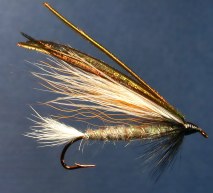Invicta Flies - Royo
The Royo is a good minnow imitation for many gamefish, including crappie, trout, bass, and pike. The smooth undulating motion of the marabou wing makes it top-rate for stillwater fishing. Moderate to slow, foot-long strips on the retrieve, with a slight pause between brings aggressive strikes from pursuing fish. The white Royo is the all around best producer, and the black does quite well in murkier waters.
 |
Hook: Mustad 3665A, #6-10
Weight: .015 lead wire
Thread: 6/0 black
Tail: white marabou
Ribbing: fine oval silver tinsel
Body: Mercury Dubbing, pearl
Collar: black saddle hackle
Wing: brown bucktail, white marabou, peacock herl tips
Head: glossy black (two coats of cement or use Loon's Hard Head)
|
Tying Instructions:
1) Wind the lead wire onto the shank to cover the front 2/3. Secure the thread to the rear of this, then spiral it over back and forth to secure...about six times is adequate. Bring the thread to the bend.
2) Tie in small clump of marabou just slightly longer than the hook gap. Trim the excess.
3) To the top of the shank, lash the tag end of the fine oval silver tinsel, leaving the rest to extend back beyond the bend to be wound later.
4) Dub a tapered body of pearl Mercury Dubbing up to about three hook eye widths behind the eye. Counterwrap the ribbing forward, tie off and clip the excess.
5) Select a black saddle feather with fibers about twice as long as the hook gap. Tie this in on the underside of the hook immediately in front of the body. Take four or five turns, stroking the fibers back as you do. Tie off on the underside of the hook and clip the excess. (Tying this down on the underside helps us end up with a more uniform head.)
6) Clip a small bunch of bucktail from the brown section of a natural white bucktail. Select hair closer to the tips, which is finer and not as hollow. A couple dozen fibers is plenty, as we want this to be rather sparse. The main function of the bucktail is to flare and "hold up" the marabou part of the wing. Even up the tips by hand. Measure and note where the length is the same as from the front of the body to the tip of the tail and tie in on top of the shank. Clip the butt ends at an angle and secure with three more tight wraps. Add cement for durability.
7) Gather a sparse bundle of fine-tip, long marabou fibers. Be sure not to get too much marabou here, or the fly will have trouble sinking. Measure to the same length as the bucktail and tie in directly on top. Clip the excess.
8) Tie in five strands of peacock herl as a topping so the tips curve to the very tip of the tail (this should make them a bit longer than the wing itself). Clip the excess.
9) Build up a smooth, tapered head with the thread, whip finish, and cement twice. For a real glossy head and classy look, caot the head with Loon's Hard Head in black.